
|
An Astrological Dilemma:
Polar Latitudes by Alova
Meet "Andrea," the imaginary twin of Andrey, who was born on January 1st, 2000, in Murmansk, Russia, a city about the size of Tampa, Florida.(1) Andrey was born at 12:00:30 am, and "Andrea" was born at 10:19:36 am. As you can see from the wheels below,(2) Andrea's Ascendant and Midheaven are conjunct. The Midheaven appears in the 12th house. One second later, at 10:19:37, the Midheaven appears in the 1st house in the wheels below: 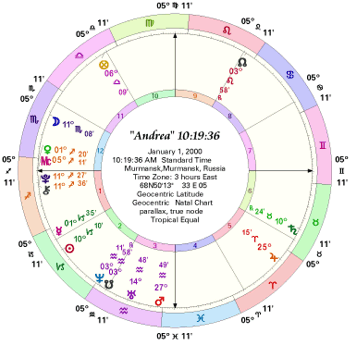
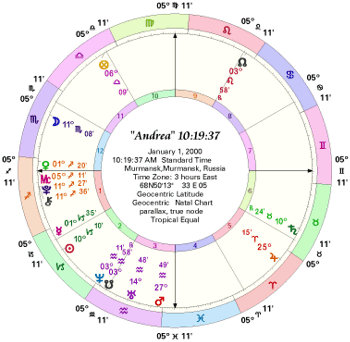 Notice that these charts are shown with the Equal House System; why? Did you realize that the Placidus, Koch, Campanus, Regiomontanus, Albacitus, Poli-Equatorial (Carter), Horizontal, and Sunshine House Systems are not even defined for Arctic latitudes? Yet hundreds of thousands of people are born there. Did you realize that the Porphyry, Natural Gradation, and Sripati House Systems also cannot be used to even draw a wheel with the above data? Try entering the data into your astrological program, with any of the above house systems. You may see results like this: (3) 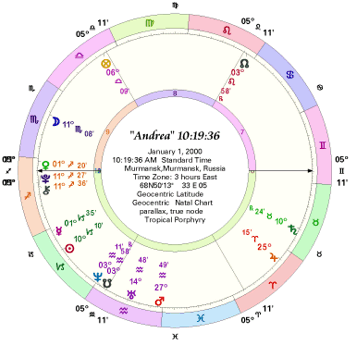
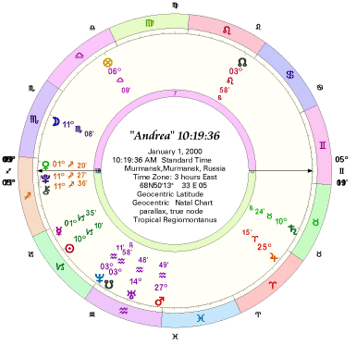 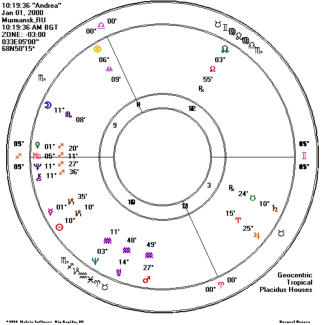
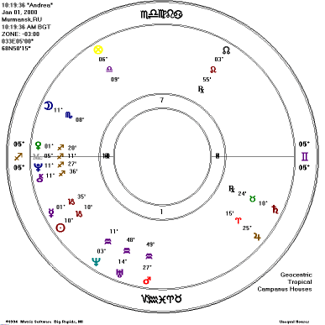 Meet "Andrei," the imaginary triplet of Andrey, born the same day, the same place, at 1:53:00 pm. Andrei's Midheaven and Descendant are conjunct. In the Equal House Wheel, the Midheaven appears in the 6th house. One second later, the Midheaven appears in the 7th house: 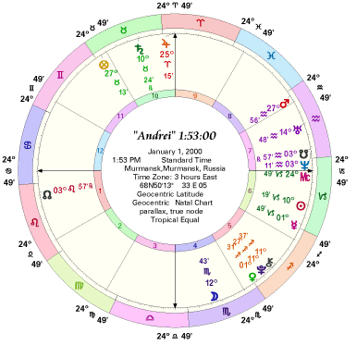
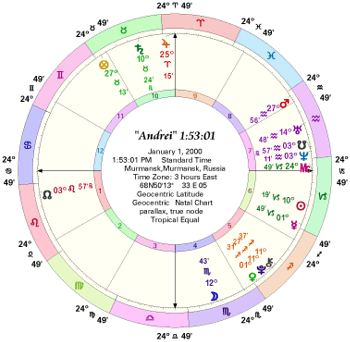 Again, none of the house systems mentioned above is capable of constructing a wheel for Andrei. It is long past due that astrologers address this embarrassing dilemma. Second, there are volumes of scientific evidence that the Ascendant and Midheaven at the time of birth are related to actual characteristics. Michel and Françoise Gauquelin pioneered this research(4) and studies have been replicated that show, for example, that people with Mars near the Ascendant or Midheaven are significantly more likely to be athletes or warriors than others, and that people with Jupiter near the Ascendant or Midheaven are more likely to be arrogant. Honest scientists cannot ignore the significance of both the Ascendant and Midheaven. Third, the most commonly used house system is Placidus-because it works! It works well, and has worked well since its invention. The studies above were conducted using geocentric horoscopes with the Placidus House system. Although many astrologers who understand the geometry behind a horoscope wheel have proposed numerous other house systems, Placidus remains prominent despite its utter failure at polar latitudes. Even many Vedic astrologers now use and recommend the Placidus house system.(5) Interpretations of astrology wheels using Placidus are quite accurate, although there is much room for improvement and research. First, let's examine, with pictures, why the Ascendant and Midheaven "behave strangely" at polar latitudes. Geocentric (Earth-at-the-center) Astrology looks at the sky from the viewpoint of a person at a specific point on the surface of the Earth. We can only see half of the sky at a time, and this half is represented by the top half of the horoscope from the 12th to 7th houses. Using Placidus (or any other system based on Ascendant and Midheaven), the point right above us is represented by the cusp of the 10th house, the "high noon" point of a horoscope, and the point below us, underneath the Earth, is represented by the Nadir, hidden and deep. The point of the zodiac that is just appearing on the Horizon is represented by the Ascendant, the most powerful and significant point at a given moment. The signs of the tropical zodiac are defined as arcs in Ecliptic, the Earth-Sun plane, with the center of the Earth at the apex. 0° Libra is defined as the direction of the Sun at the moment of the September Equinox, and 0° Cancer is defined as the direction of the Sun at the June Solstice. (Fig. 1) 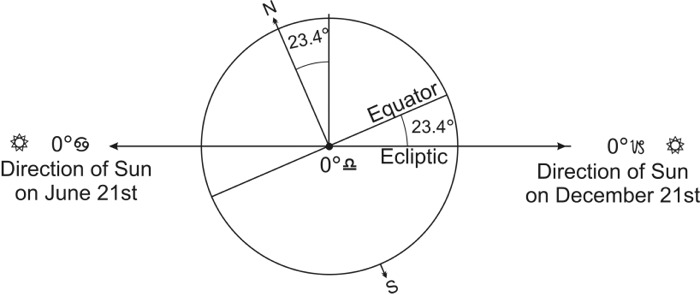 The Ascendant is defined as the intersection of the Eastern side of the Horizon with the Ecliptic plane, which represents the power of sunrise. If we are at the Equator, then our Horizon passes through the North and South Poles. Since the Earth is tilted at 23.4° to the Ecliptic, our Horizon intersects the Ecliptic at a latitude somewhere between 23.4°S and 23.4°N, depending on the time of day and time of year. At noon on June 21st and midnight on December 21st, the Sun is at 23.4°N, and at noon on December 21st and midnight on June 21st the Sun is at 23.4°S. (Fig. 2) 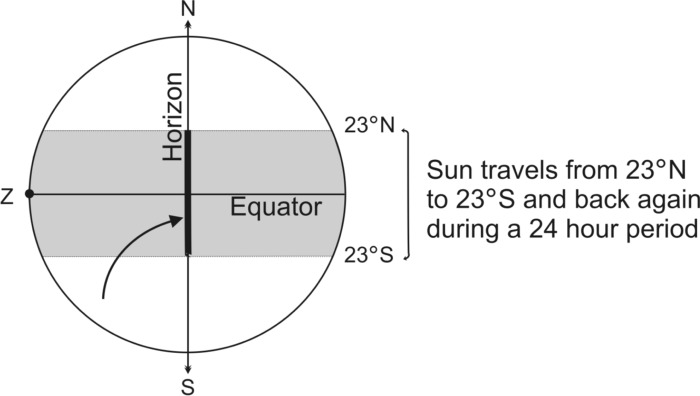 If we are at the Tropic of Cancer at 23.4°N, our Horizon is tilted at 66.6° to the Equator, and so the Horizon can intersect the Ecliptic throughout a broader range for a given period of time. (Fig. 3) If we are at a latitude of 45°N, the Horizon is tilted at 45°, and the Ascendant can "travel" faster or slower over a still broader range of the zodiac in a given time. (See Fig. 4)
If we are still further north, just at the Arctic Circle at 66.6°N, the Horizon and Ecliptic intersect completely, over the entire range of the zodiac, twice a day. (See Fig. 5) This is another way of expressing the fact that at the Arctic Circle, the Sun can rise an instant before its culmination at high noon and set an instant later, or set an instant before midnight and rise an instant afterwards. Spatially, this causes the astronomically defined Ascendant to be conjunct the Midheaven or the Nadir. The Ascendant is still defined except for two split seconds, but its relevance in a horoscope is questionable, as shown for Andrea and Andrei. 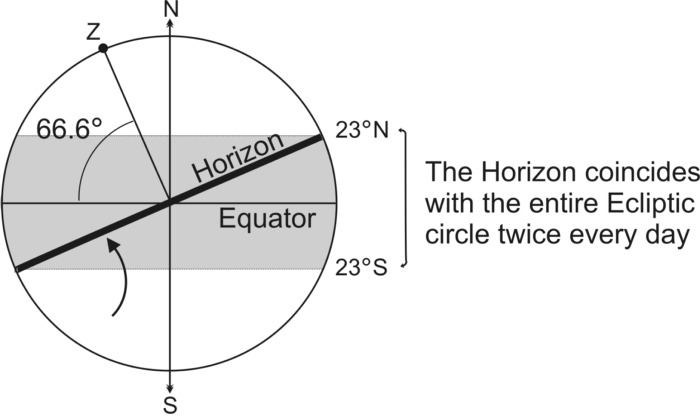 Just above the Arctic Circle at 67°N, there is one day per year when the Sun does not rise and one day per year when it does not set. On these two days, 0°Cancer and 0°Capricorn never intersect the Horizon. For all latitudes above 67°, twice a day the Horizon coincides with the Ecliptic, and two sections of the zodiac never touch the Horizon. On January 1st 2000, the degrees between 5 12' Gemini and 24 28' Cancer, and the degrees between 5 12' Sagittarius and 24 28' Capricorn, never rose to the Horizon in Murmansk. At 10:19 am and 1:53 pm, as shown in the charts for Andrea and Andrei at the beginning of this article, the Horizon coincided with the Ecliptic, and the Midheaven was conjunct the Ascendant or Descendant. Everywhere in polar latitudes, there are dates and times when sections of the zodiac never rise or set. Here, the astrological Ascendant that works so well at lower latitudes fails us completely. (See Fig 6) 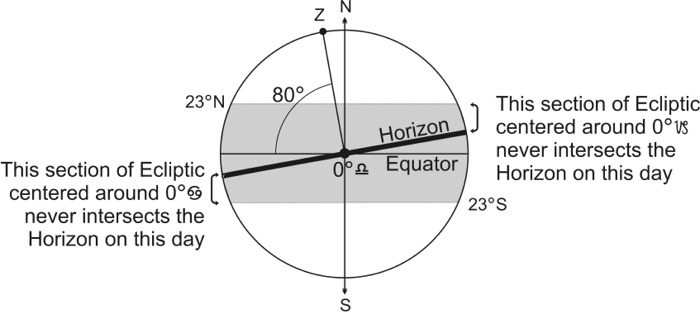 So, although we know that the traditional, geometrically-defined Ascendant provides meaningful astrological information, at some times it is actually conjunct or opposite the geometrically-defined Midheaven, which also provides meaningful astrological information. To solve this problem, we have only four choices:
For geocentric astrology, there are no other possibilities. Since Placidus and other house systems that use the Ascendant and Midheaven as the cusps of the 1st and 10th houses, respectively, are so widely used precisely because they yield accurate interpretations, most of us would not wish to consider (1) or (2). Many such proposals have already been made over the last couple of centuries, but not one has been widely adopted. In considering our two remaining options, we need to consider the day of Nature that a horoscope is designed to reflect. Let's look at a day, in different latitudes and different seasons. Usually, the most potent time of day is sunrise, and the second most potent time of day is high noon. (The Ascendant and Midheaven reflect the power of these special directions.) Suppose you are standing at the North Pole, facing, say, Greenwich at 0° (all directions on the Earth are South to you). In December, you will never see the Sun. Sometime around the end of January, you will see the faint glimmer of a red sky. The pale red area will first appear at the horizon and travel all around you in a circle, from left to right, in 24 hours, and will not disappear. Every day the red glow will become a little brighter and broader, and travel all around you. Sometime in early March, you will finally see sunlight. The Sun's first rays will travel all around you, from left to right, in 24 hours. You will be able to see them all day long, and each day they will get gradually brighter. They will not get more or less bright from hour to hour. Instead, each day you will be able to see a little more of the Sun as it travels in a circular path all around you. On the March Equinox, you will see exactly half of the Sun. It will move around from your left, and will arrive at your right exactly 12 hours later. Then it will move behind you, and you will be able to see it if you turn your head around. All day long, for 24 hours, there will be the exactly the same amount of daylight. The following week you will see the entire Sun, all day long. It will move around you in a circle along the Horizon, getting gradually higher in the sky. On June 21st, the Sun will reach its culmination at 46.9° above the horizon, the highest point in the sky it will ever get during the year. As usual, it will travel in a circular path all around you from left to right. The following week will look the same, except it will be just a little lower in the sky. Finally on September 21st, only half of the Sun will be visible, all day long, as it travels around you in a circle. A couple of weeks later, you will see a bright red glow travel all around the horizon in the same circular path, but you will not see the rays of the Sun again until next March. Notice that right at the North Pole, there is only one "day" per year. The Sun rises only once and sets only once. The time it takes for the Sun to rise is perhaps a month; the time of dawn is perhaps 2 months, the time it takes for the Sun to set is around a month, and the time of dusk is again around 2 months. The length of the "day" at the North Pole is about 6½ months, and the time of "night" (including dawn and dusk) is about 5½ months. The Midheaven is a direct, astronomical measurement, astrologically representing the center of our day, our "high noon." At any instant, the Midheaven is the same for all latitudes. The Ascendant represents the beginning of our day, our Sunrise, which varies with latitude. At polar latitudes when the Sun doesn't rise, people still get up around what would be sunrise and retire around what would be evening if the Sun were to rise. Isn't it evident that we must make a change in our definitions of Ascendant and Descendant to account for this new type of "day" at the Poles? Now, let's move to the Equator. On December 21st, the Sun rises at 6 am from 23° Northeast, travels to an elevation of 66.6°S above us at High Noon (LMT), and sets at 6 pm at 23° Northwest. Each day the Sun rises from a slightly more East-northeasterly direction, reaches a little higher in elevation at high noon, and sets more West-northwest. On March 21st, the Sun rises exactly due East, travels to an elevation of 90° exactly overhead at high noon, and sets exactly due West. The next day, the Sun again rises at 6 am, from a slightly Southeasterly direction, travels to its highest point over our heads to just a little bit North, and sets slightly Southwest. This trend follows until June 21st, when the Sun rises at 6 am from 23° Southeast, travels to an elevation of 66.6° N at high noon, and then sets at 6 pm at 23° Southwest. When we say that the Sun "moves northward" from December 21st to June 21st; we are referring to the fact that its highest point in the sky, from day to day, moves northward. The following day, the Sun's highest elevation at high noon is just a little South of where is was the day before. Each day the Sun rises a little closer to due East, culminates a little less North, and sets a little closer to due West. On September 21st, it rises from exactly due East, travels to exactly overhead, neither North nor South since we're at the Equator, and sets exactly due West. Thereafter, it rises from Northeast, travels to its culmination a little South, and sets a little Northwest, until December 21st when the cycle starts again. At the Equator, and only at the Equator, the Sun rises at 6 am and sets at 6 pm every day throughout the year. Now, imagine you are just below the Arctic Circle, at 66.5° North. On December 21st, you will see the Sun for only a few minutes; it will rise just before noon (LMT) and set just after noon. It will appear at the Horizon just slightly East of due South, and disappear slightly West of due South. The next day, you will see it a few minutes earlier from slightly more Southeast, and it will set a few minutes later slightly more Southwest. Each day it will rise earlier, from a more easterly direction than the day before, rise a little higher in the sky, and then set more to the West. Finally, on March 21st, it will rise exactly due East at 6 am, continue to 23.4° above the horizon at high noon, and set exactly due West at 6 pm. Each day thereafter it will rise from a little more Northeast, culminate a little higher, and set a little more Northwest. On June 21st, it will rise from 23° Northeast, continue to its maximum elevation of 46.9° above the horizon, and set at 23° Northwest. Again, the process will reverse for the rest of the year. If you are a little further North, above the Arctic Circle at 67°, what you see will be almost the same, except that on December 21st the Sun won't rise at all and you will see only a bright red glow at the South point of the Horizon, and on June 21st the Sun won't set but will travel all around you in a circle and not set until the end of the following day. At higher latitudes within the Arctic Circle, in December or January you will see a bright red glow. It will travel along the Horizon in a circle around you, gradually becoming brighter and broader. Eventually you may see a red glow all over the horizon, but there will be a brightest direction and a dullest direction. The brightest area will be like dawn just before Sunrise, and the dullest area will be like dawn long before Sunrise. The brightest and dullest areas will be exactly 180° apart, and will travel all around you in 24 hours. The direction of the brightest area is the direction of the Sun, which still lies hidden just below the horizon. This position will move 1° each day, Eastward (toward your right), against the background of stars. Eventually you will see the Sun's rays, for perhaps a few minutes the first day, and for a little longer each day thereafter. A month later you will see the Sun fully at high noon, and only the top of it at "midnight." Another month later, you will see the Sun as it travels all around you in a circle, but its elevation will be greatest at high noon and lowest at your "midnight," until its motion reverses on June 21st. There is one more thing to notice before moving on. At the Equator, the Sun rises and sets quickly, within only a minute or two. We have to travel to higher latitudes to enjoy the glorious sunrises and sunsets that seem to last an hour. The pretty sky colors are due to refraction of the Sun's rays, but in addition the Sun rises and sets at a greater angle, so it "moves" diagonally rather than vertically, from our viewpoint. The Sun "ascends" and "descends" more gradually at high latitudes than at the Equator. The exact time of Sunrise, although it can still be calculated, is less precise at high latitudes near solstice times-especially in our human experience. Let us consider our "days" at Arctic latitudes. The day is a basic time period of life, encompassing mundane routines like waking, working and sleeping. A day is 24 hours, the period of rotation of the Earth. If a day were from sunrise to sunrise, then a day at the North Pole would last 6 months, and someone living in polar regions would get no sleep during summer months and would sleep all winter. No, the definition "day" that makes sense in astrology is the period of one spin of the Earth on its axis. This occurs at all latitudes. The beginning of our day may change seasonally; we may arise with the Sun and work longer during the summer months and we might sleep more during the winter. But even if the Sun doesn't rise, we will still get up on a daily basis! So should be the astrological Ascendant, the cusp of the 1st house. The "high noon" point, represented by the Midheaven, is an easy and unambiguous astronomical measurement, and remains the center of our day even at polar latitudes. We should look to the Ascendant, option (3) above, to solve this sticky astrological dilemma. The traditional astrological formula for the Ascendant is based only upon geometry (at an instant), but not upon time. The house systems that base their calculations for house cusps on both time and geometry (space)-Placidus, Koch, and Topocentric- work well astrologically. We must adjust our geometrical formula for the Ascendant. It is the only option that makes sense. A future article will present a simple modification in our definition of the Ascendant, with a house system that is almost identical to Placidus for equatorial and tropical latitudes. This house system can be easily used for constructing horoscopes above the Arctic circles. It also reflects Nature and the day our horoscopes are designed to reflect. It Stay tuned to ISAR! References
List of Figures
Posted with permission.
|
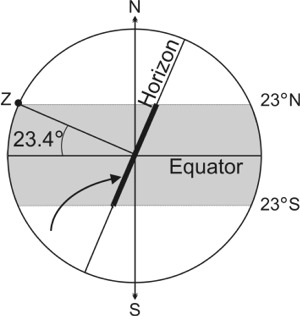
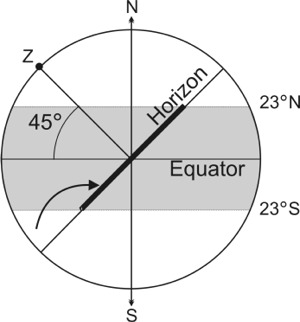
 AUTHOR:
AUTHOR: 